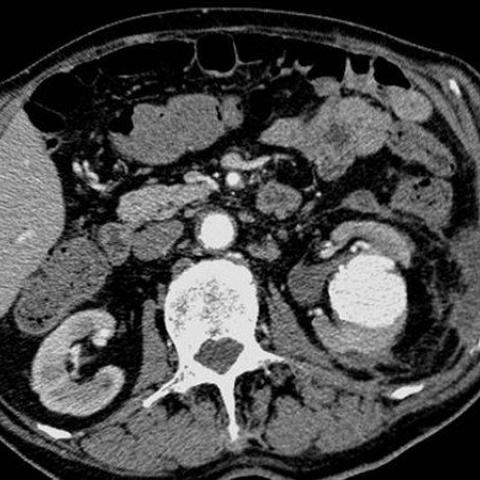Clinical History
A renal pseudoaneurysm occurred after doing a open partial nephrectomy in a 57-year-old male, and this treated by selective and superselective coil embolization.
Imaging Findings
A 57-year-old male patient with a history of a solid left kidney mass that could be occasionally diagnosed underwent nodulectomy, through an extraperitoneal flank incision. The lesion was removed,
and intraoperative hemostasis was achieved. No complications occurred after the intervention, and the patient was discharged a week later. A pathologic analysis that was done revealed the presence of
a benign oncocytoma. Thirteen days later, the patient complained of having a persistent gross hematuria and an intermittent left-side flank pain. It was found that his serum creatinine level was 1.80
mg/dl and hemoglobin and hematocrit were 8.8 g/dl and 26.3%, respectively. An ultrasound (US) examination when done revealed a partially organized fluid collection within the left renal parenchyma.
Computed Tomography (CT) was performed, demonstrating a pseudoaneurysm in the left partial nephrectomy bed site. A digital subtraction angiography (DSA) when performed confirmed the presence of a
vascular lesion which was supplied by segmental arteries. Selective and superselective coil embolization was performed. Post-procedural DSA demonstrated the occlusion of the pseudoaneurysm associated
with devascularization of about 30% of the residual renal parenchyma. No complications occurred; the gross hematuria was solved, and the hemoglobin remained stable. A CT follow-up at 7 and 14 days
revealed persistent arterial enhancement of the pseudoaneurysm, which appeared to be reduced in size. The patient therefore underwent a further superselective embolization, which successfully
occluded an injured interlobular artery. Six days later, a CT examination that was performed confirmed the successful devascularization of the lesion.
Discussion
Renal artery pseudoaneurysm (RAP) is a rare and known complication of partial nephrectomy, due to bleeding of an injured artery. It can also be caused by a penetrating or blunt renal trauma and
percutaneous procedures, such as a renal biopsy, pecutaneous nephrolithotomy or pecutaneous nephrostomy. The RAP can be asymptomatic or can determine flank pain, gross hematuria, renal dysfunction,
retroperitoneal hematoma and, in severe cases, acute hypotension. US, color Doppler US (CDUS) and CT are essential tools to be used in the diagnostic work-up. US is used in the first-line
examination; it allows the evaluation of renal morphology and structure, and is able to identify retroperitoneal or renal hematoma and abdominal effusion. CDUS can reveal the blood flow within the
fluid collection. The presence of a periodic inversion of flow direction (to and from sign) is characteristic at the level of the junction between the pseudoaneurysm and the injured artery. A
contrast-enhanced spiral CT is highly sensitive in the detection of the pseudoaneurysm, and it is able to reveal paranephric, perinephric or nephric hematomas, blood clots into the urinary excretory
tract and other abdominal abnormalities. Multidetector spiral CT improves detection of a pseudoaneurysm through an increased spatial and temporal resolution with a higher depiction of its extension
and vascular feeders. Nevertheless, DSA still represents the gold standard in the diagnosis of RAP, in particular for the visualization of the injured parenchymal arteries. The treatment strategy
relies upon the patient 's cardiovascular condition. In hemodynamically stable patients, a close clinical, laboratory and imaging surveillance may be sufficient. Percutaneous intravascular
embolization is indicated in the case of persistent bleeding. The use of micro-catheters allows one to perform superselective embolization of the injured vessels, thus sparing the non-affected renal
parenchyma. Several embolizing agents can be used, and the choice of the embolic agent is mainly dependent on the operator’s experience. The most common complications after percutaneous
treatment are represented by embolization of non-injured arteries, arterial dissection or rupture during catheterization, post-embolization syndrome, renal dysfunction and arterial hypertension.
Surgery is indicated in hemodynamically unstable patients and after a failed percutaneous embolization. Suturing the vascular wall lesion or ligaturing the bleeding artery is the desired treatment,
although partial or total nephrectomy is often required. A US, CDUS and CT follow-up is required to evaluate lesion devascularization and its progressive scarring; besides, it is able to depict
post-procedural complications, extension of devascularized parenchyma and dissolution of ureteral blood clots.
Differential Diagnosis List


